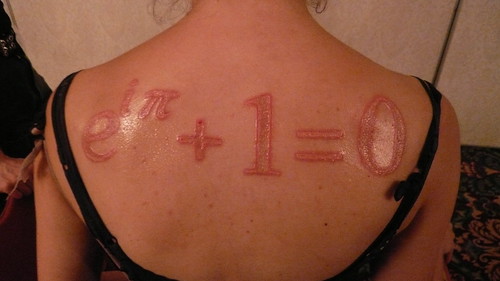The Maths Orgy Thread
-
What goes up must come down, or vice versa. Done, with no maths at all.
-
There's a neat, easy proof. Will read yours properly later voices, to see if it equates to the same thing!
-
So what's the difference between a proof and an axiom, and is not Goober's example an axiom?"I didn't get it. BUUUUUUUUUUUT, you fucking do your thing." - Roujin
Ninty Code: SW-7904-0771-0996 -
Oohh, I hope so.
-
An axiom is something you state/assume/define.
A proof is something you conclude based off those axioms.
Without any axioms you can't really get going. Though there's interesting philosophical / logical stuff about what the "right" axioms are, though that's probably not even a meaningful thing to ask.
Eg. Wiki the axiom of choice for the interesting one in that regard.
-
I'm not sure "what comes up must come down" is either really I'm afraid. Though it is oddly close to the snazzy proof alluded to earlier...
-
It's pretty much the same as mine too - if the statement is incorrect you are left either with a function which isn't continuous, or a function which gets lower/higher over every half rotation of the circle (thus meaning you can't get back to your original point). You've got to be able to get back to where you started.
-
That's basically a variation on reductio ad absurdum (I think?). You make an assumption and then via logical steps arrive at an impossible conclusion which proves the assumption wrong.Holding the wrong end of the stick since 2009.
-
I have done a 3d model of my proof. The maths is very complicated so I thought it best to not show my workings.

-
It's a bog standard mathematical proof by contradiction (which is probably the same thing).
-
Here comes a new problem*:
We all know (and love) that 3^2 + 4^2 = 5^2
Some even know 10^2 + 11^2 + 12^2 = 13^2 + 14^2
You may even be aware that 21^2 + 22^2 + 23^2 + 24^2 = 25^2 + 26^2 + 27^2
What is the next equation in this sequence, in which each equation involves an odd number of consecutive squares?
*Saturday Guardian readers need not apply!iosGameCentre:T3hDaddy;
XBL: MistaTeaTime -
Is the next question "why does that happen"? How many marks is that?
I find this kind of stuff seriously distracting. Curse you all! -
RamSteelwood wrote:Obviously i'm not really dismissing it all, but to my mind i can grasp pi and e cos they can be shown as 'proper normal real decimal numbers to an accuracy that is acceptable to me' (not sure what the official term for that is!)
i appears to be 'whatever 'number/concept' is convenient to make the formula work'.
playing around Euler's identity, i = (pi * i)/ pi
total scam!
'i' isn't some randomly fudged together number, designed to make stuff work. It's essentially a place holder for a number that couldn't otherwise be defined.
Your playing around with Euler's id has shown that i=iiosGameCentre:T3hDaddy;
XBL: MistaTeaTime -
As I might stereotypically say:
Why i? -
i for imaginary.
Edit: I've just always assumed that, it could be more related to unit vectors (i, j, and k), the unit circle is quite an integral part of the background maths.iosGameCentre:T3hDaddy;
XBL: MistaTeaTime -
Right, before the proof, somebody asked for a noddy explanation of all this shizzle (i, e, pi, euler's identity, complex numbers). So, feeling brave, I'm giong to try. Indulge me. And ask questions...
Let's start with i. i is kinda useless by itself. i only becomes useful if you square it. In fact, that's how it's defined - the thing that if you square it you get -1.
So, what is i? Well, doesn't really mean much till you square it.
But, if you then start doing maths with it, fun stuff happens.
Like, what's (2i) squared? Well that's (2i)^2 = (2*i)^2, and you can multiply out, so = (2^2) x (i^2) = 4 * i^2, and i^2 = -1, so that's -4. Whoop.
But then, more fun things happen. Like, what are the solution to x^2-2x+2=0? (i.e. the values of x for which that formula holds true; it doesn't for x=1 say, as that's 1^2-2x1+2 = 1-2+2 = 1, not 0).
You may remember the formula, x=(-b +/- sqrt(b^2-4ac)/2a. Let's try it.
x = (-(-2) +/- sqrt((-2)^2-4x1*2))/2x1
= (2 +/- sqrt(4 - 8 ))/2
= (2 +/- sqrt (-4))/2
oh wait, we just decided that sqrt(-4) = 2i.
So
x = (2 +/- 2i) / 2 = (1 +/- i)
Nice.
Let's test it (with (1 + i)).
x^2-2x+2 = (1+i)^2 - 2x(1+i) + 2
= (1^2 + 2i + i^2) - 2(1+i) + 2
= (1 + 2i - 1) - 2 - 2i + 2
= 0 as everything cancels.
Whoopitydoop.
More to follow.... -
OK, let's park imaginary stuff for a sec, and hit e.
Now, useful thing here is "Talyor expansion".
This says tells us that the following (thanks wiki!)

So that seems kinda innocuous. But, believe it or not, it works. I have an excel spredsheet to prove it.
clickety click: here
Top section is e^x, and I've done it so if you type a number in the x column (A10-A12), it works out each of those terms above, and then adds them up over in T10-T12, and compares that with the actual e^x. You can see it's basically right (and only wrong cos I don't have a wide enough spreadsheet.
So, if you put x = 1, what happens? You get 1+1+1/2!+1/3!+1/4!+... and that adds up to e^1 (i.e. e). And that in fact adds up to 2.7182818 per my spreadsheet. So, not a random number, one with a very precise definition. -
At that point I already find it kinda beautiful. Why should an exponential function be expressable as the sum of lots of expoents, all over factorials?
No idea. It's kinda magical.
More so if you know how to differentiate...
x^n differentiates to (x^(n-1)) x n.
So, differentiate e^x, and you get...
1 -> 0
x -> 1 = 1
x^2/2! -> x^1 * 2/2! + x
x^3/3! -> x^2 x 3/3! + x^2/2!
...
x^n/n! -> x^(n-1)xn/n! + x^(n-1)/(n-1)!
+ x^n/n!
= e^x
i.e. it differentiates (and hence integrates...) to itself.
Maigcal stuff. -
Bored yet? I'm just warming up...
-
Right, next up, pi
 .
.
Back to wikipedia:

OK, random formulae. But, back to my spreadsheet please...
- Put (x=0) in, and you get sin(x)=0, cos(x) = 1.
- Put x=3.14159 in, add up all those powers of x (as per my spreadsheet), you get sin(pi)=0, cos(pi)=-1.
- And other values work too.
So, pi is very kinda of natural, in that it's the first number that gives you zero if you bung it into the sin expansion above. You can't _choose_ a different pi, because it wouldn't have 0 as it's sin.
So that's kinda where radians come from, as opposed to degrees. They're "natural". -
Now, I find it even weirder that cos and sin have expansions like that. Like WTF, you increase x a bit, and the sin ones goes up (as x is the dominant term), then it gets higher and the x^3 bit is the most important term (as it's only / 3!, which is smaller than 5!). And that has a negative sign, so the wave starts coming down again. Then up again when x^5 is the dominant term.
But how the hell does it have such smoothe beauty? Why does it repeat every 2pi? You'd never guess it by looking at that expansion. -
Right, now the proper magic happens...
What if in stead of x, we put ix into the e^x formula?

So
e^ix = 1 + (ix) + (ix)^2/2! + (ix)^3/3! + (ix)^4/4! + ...
Now let's get rid of the all the i^2 = -1, i^4=(i^2)^2 = (-1)^2=1 stuff...
= 1 + ix -x^2/2! - ix^3/3! + x^4/4! + ...
Now let's gather terms with i in:
= (1 - x^2/2! + x^4/4! + ...) + i (x - x^3/3! + x^5/5! + ....)
But hang on a sec... that means ...
e^ix = cos(x) + i sin(x)
That some crazy shizzle. -
Then comes some beauty. What do cos and sin mean? Angles and triangles and stuff:

You can end up plotting a number of the form (x + iy) (where x and y are normal numbers) in a diagram. x is the 'real' part, y the 'imaginary' part. So 1 is on the x axis (it has no imaginary part), and y is on the imaginary axis (it has no real part).
Then choose some random other 'complex' number z, with both real and imaginary bits. Call r the distance from the origin, theta the angle to the axis.
Magically, via trigononmetry, the x distance is (r cos(theta)) and the imaginary bit is (r sin(theta)).
So, you're number is r cos(theta) + i r sin(theta) = r ( cos(theta) + i sin(theta) ) = r e^(itheta) per above. -
Finally, then, you can see that if you put r = 1, theta = 180 degrees, i.e. pi, then you back at -1 on the x axis, 0 on the y axis.
i.e. -1 + 0i = -1.
And, hence -1 = r e ^ (i theta) = 1 x e ^ ( i pi)
i.e.

Simples.
Right that's me done for the night, it's the effing weekend. -
Oh actually here's the nice solution to the ring problem. Hope it makes vague sense.

-
That would have been my proof.
I like a nice visual proof.
Like the pythagoras proofs - I think I could write down at least 5 but there are many more - but the pictorial one is the best. -
There are hundreds apparantly.Holding the wrong end of the stick since 2009.
Howdy, Stranger!
It looks like you're new here. If you want to get involved, click one of these buttons!
Categories
- All Discussions2,713
- Games1,877
- Off topic836








